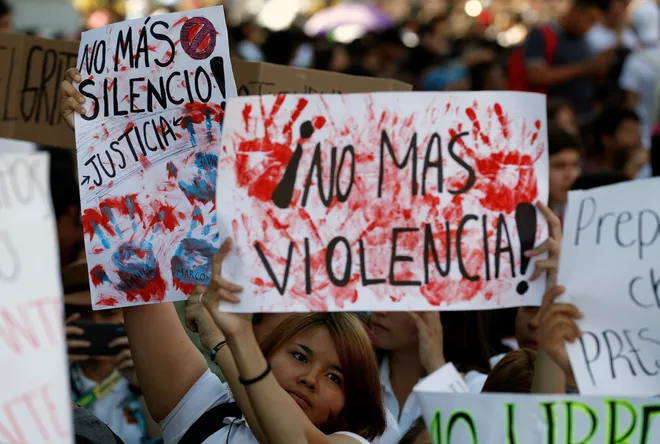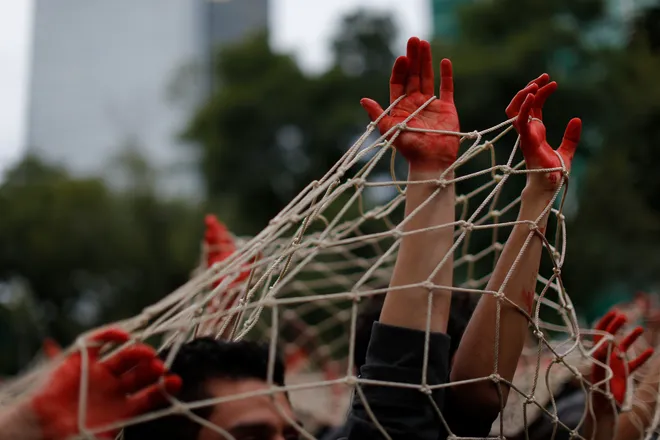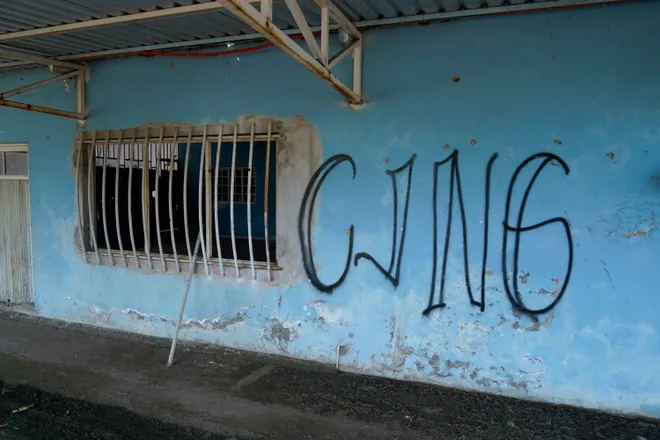The power of blood: Why Mexican drug cartels make such a show of their brutality

MEXICO CITY — Body parts found inside freezers, bodies hanging from bridges, young men killing each other under cartel orders.
Mexico is no stranger to displays of brutality put on by the nation’s drug cartels.
Bodies hanging from bridges is a near daily occurrence, a display that dates to the early 2000s, when it first astonished the population of a small town in central Mexico.
Other times, the shows of violence reach new, horrific levels.
In 2006, gunmen stormed into a bar in Uruapan and tossed five human heads onto the dance floor.
“The family doesn’t kill for money. It doesn’t kill women. It doesn’t kill innocent people, only those who deserve to die,” the accompanying “narco-message,” allegedly signed by the Familia Michoacan cartel, read.
In August, authorities found dozens of bodies, cut into parts and frozen inside several freezers in houses in Veracruz. Several people were detained, with officials alleging they are members of the Jalisco New Generation Cartel (CJNG), one of the most brutal cartels in Mexico.
Experts who study and watch Mexico’s drug cartels say the overt displays of brutality have become part of the cartels’ dynamic, their modus operandi. Their purpose is to generate fear in the authorities, in their enemies and the populace.
‘Blood is a sign of power’
Over the years, different cartels have implemented multiple brutal strategies. Though now mostly extinct, the ruthless Zetas cartel was the pioneer in this nefarious field.
“The Zetas were the ones who launched this new stage of bloodshed in the contemporary history of drug trafficking in Mexico,” Mexico-based security analyst David Saucedo said.
The criminal group from the northeast of Mexico, an armed wing of the Gulf cartel, set the stage with a series of high-impact events and atrocities, reports show.
“The dismemberment, dissolving corpses, and hanging bodies on capital bridges was put into practice by the Zetas in order to intimidate their adversaries in order to mark territory,” Saucedo explained.

The San Fernando massacre was one of the most high-profile incidents attributed to the Zetas. It took place in Tamaulipas state in 2010, only 93 miles from the U.S. border.
The Zetas killed 72 migrants from Central and South America who were en route to the United States. The migrants were shot in the back of the head.
“Drug traffickers in Mexico brag about their killings with show-off practices. Barbarism is a scene of power. Blood is a sign of power,” Laura Etcharen, a sociologist and consultant on drug trafficking issues, told The Louisville Courier Journal, part of the USA TODAY Network.
“Narco power is real. Each organization will be bloodier according to its goals and competitiveness. Blood also depends on each government, on the levels of corruption and penetration, but also on the ability to address it,” Etcharen said.
Even though Mexico is the main stage for the most graphic shows of cartel brutality, experts say this follows a similar script used by terrorist organizations elsewhere.
“Mexican criminal organizations are not that original. When they started spreading executions and these kinds of things, they got it from the Islamic State,” security expert Javier Oliva said.
“The Islamic State was the first to publish the video recordings of the torture and killing of their hostages, and then cartels copied that,” Oliva said.
‘Narco-banners’
For over a decade, cartels have used public banners and signs to send ominous messages.
Like the displays of violence, these “narco-messages” have an intention, experts say.
“It is a violence that has a communicative component. This component has more than one type of recipient,” said Claudio Lomnitz, Campbell Family Professor of Anthropology at Columbia University.
Lomnitz said there are three different recipients for these messages: The first is a private audience, their enemies — the people who are killing each other between rival groups; the second is a more public audience — local residents or the media.
“But also, there is a third one, which is within the cartel. It also has a meaning there because they often use these types of violence as forms of training or recruitment of people... Brutality also becomes a standard of socialization and recruitment.”
The messages are usually written on white blankets, some more produced than others, with frequent spelling errors and a signature of the person or group taking responsibility — and they are almost always displayed next to corpses or body parts.
“In these short and fragmentary texts, it is possible to perceive the emergence of an incipient political discourse,” anthropologist Natalia Mendoza Rockwell said in her 2016 postdoctoral paper “Narco-mantas o el confín de lo criminal, Acta Poética.”
“These banners display an idea of justice, a search for public legitimacy, and fragile attempts to occupy the voice of a popular ‘We.’ The distinction between the criminal and the political is at stake in the interpretation of the violence that these banners attempt to impose,” she wrote.
Mendoza Rockwell said narco-banners’ “central objective is to dictate the interpretation of a violent event and appropriate its symbolic force.”
One of their most important characteristics, “is that they are simultaneously addressed to the ‘people’ and to ‘the authorities’ or to ‘Mr. President.’ In that sense, rather than making a threat, they express some kind of grievance or demand.”
‘Heating up the plaza’
Beyond the anthropological and political intention of the cartels’ atrocities, experts say there’s a tactical meaning behind them.
“Those events are mainly to ‘heat up the plaza,’ which in slang is known as generating a high-impact event to cause public security forces to arrive at an area and park there and halt the drug trafficking operations,” security analyst Saucedo said.
“What drug trafficking groups sometimes do is cause a massacre, a high-impact event, solely to heat up the plaza for their rival, so that the public security forces take over that area, leaving other areas uncovered, in which rival groups can operate.”

This tactical strategy is used by the two most powerful cartels in Mexico, the Sinaloa Cartel and CJNG, fueling the turf war between them and against government security forces.
Even though CJNG has been more gruesome with killings nationwide, Sinaloa has implemented different alliances that make them less bloody but not less dangerous.
“What the Sinaloa Cartel has is negotiations, agreements between equals, profit sharing and partners, while the Jalisco cartel seeks to have employees and franchises of the Jalisco cartel,” Saucedo said.
“The Jalisco cartel is more vertical, while the Sinaloa structure is more horizontal,” he explained. “Due to this authoritarian and vertical scheme that CJNG has to process, it makes them bloodier.”
Social media spreads cartel atrocities
In a video leaked on social media in August, a young man is seen being forced to kill his four friends after they were kidnapped by a drug cartel in the western state of Jalisco.
The men were first filmed in captivity alive. In the final struggle, one is forced to hit, stab and eventually saw off his friend’s head with a knife.
Authorities said they were investigating the video, and at least one person has been detained for the crime. Analysts believe the young men were force-recruited by the cartel, although an official version of the events has not been disclosed.
The gruesome video leaked on X, formerly Twitter, and is part of the daily videos the cartels leak on social media to spread their violent message.
There are multiple websites dedicated to publishing the cartels’ latest news.
Blogs that haven’t been blocked continue to receive scoops from cartel members and exclusive visuals from battles on the ground.
With the surge of different social media platforms, the cartels have found the perfect medium to share their carnage.
“Social media platforms are an incentive because often violence is made to send a message, and the medium is a way of sending a message, spreading it beyond the audience that can see it more immediately,” Lomnitz, the Columbia professor, said.
“Part of the violence is the fact that there are media that facilitate at a given moment the terror they are generating, and that the message echoes elsewhere. In that sense, I don't think there's much to stop that.”
Security experts consulted by The Courier Journal say it’s been a mistake by Mexican authorities not to address and punish the cartels’ violent acts.
“They saw it as part of the normal violence landscape in Mexico and did not realize that they were allowing drug cartels to climb a step in the level of violence allowed in the country,” Saucedo said.
Oliva said the government should demand more controls on this type of content.
“The federal government should call on the directors of the main social media platforms to help filter, prevent and censor the graphic dissemination of these types of events that are truly cruel,” Oliva said.
“It seems to me that the drug cartels have exceeded the capacity of the Mexican state,” Saucedo said.
Karol Suárez is a Venezuela-born journalist based out of Mexico City. She is a contributing writer to The Louisville Courier Journal, part of the USA TODAY Network.
Disclaimer: The copyright of this article belongs to the original author. Reposting this article is solely for the purpose of information dissemination and does not constitute any investment advice. If there is any infringement, please contact us immediately. We will make corrections or deletions as necessary. Thank you.







